Forum Falls in Akamina-Kishinena Provincial Park is one of the more obscure hikes in the Southern Rockies region. Despite the trailhead being located in Waterton Lakes National Park, the hike is still one that you’re not likely to share with many others. Waterton is a destination already suited to the hiker seeking solitude, and the small mountain park located in the very bottom corner of the Alberta Rockies is never as busy with crowds as Banff or Jasper. When I hiked the trail to Forum Falls, I didn’t see a single other person, and instead enjoyed the solitude of walking through burnt-but-regenerating forest.
When the 2017 Kenow Wildfire tore through Waterton, it burned through all of the area through which the trail to Forum Falls passes, making this hike a unique one, offering glimpses of a forest in change. Slowly the blackened trees will fall to the ground, and the small saplings now visible will rise up.
The trailhead for Forum Falls is located not far from Cameron Lake, another must-visit spot in the park. The trail heads up (never steeply) through burnt forest into Akamina Pass, where it crosses into British Columbia and finally reveals stunning Forum Falls. The trail is well-marked and easy to follow, as well as being wide and gentle, making it a perfect not-too-challenging hike for families.
Continue reading this blog post for everything you need to know to experience the Forum Falls hike in Waterton and Akamina-Kishinena for yourself, including distance, elevation gain, how to get there, the best time to visit, and lots of photos of my experience.
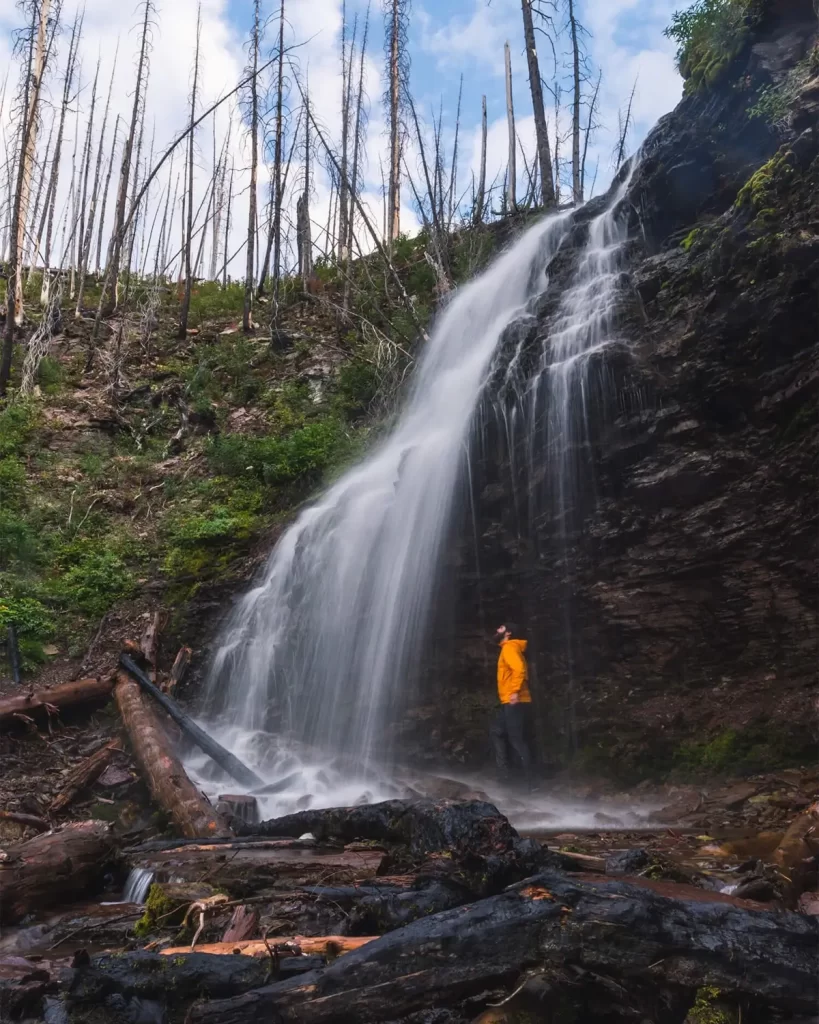
Note: The Forum Falls hike starts in Waterton Lakes National Park and continues into Akamina-Kishinena Provincial Park, meaning that a valid park pass is required. Day passes can be purchased at the park gates and are per day per person, but if you’re staying a week or longer, it’s more cost-effective to just buy an annual pass instead.
Before visiting Waterton Lakes National Park it’s essential to read up on the Parks Canada rules that must be followed to avoid tickets and/or fines. When hiking it’s important to avoid harmful practices such as disturbing plants or rock-stacking, or removing any natural object from flowers to rocks, as it’s important to leave the environment as natural as possible for the animals and for fellow hikers to enjoy in perpetuity. As many flowers as there are, there are few enough that if we all took one, then there wouldn’t be any left. If you’re after a souvenir to take home with you, there are tons of gift shops in the Waterton townsite to check out. Otherwise take only photos, leave only footprints.
If you haven’t heard of Leave No Trace principles, they’re also really essential to read up on before heading anywhere into the outdoors in general. Following these important principles basically means doing your best to leave beautiful places like Forum Falls as good (if not better) than you found them, both for their preservation and for the enjoyment of other visitors.
Forum Falls Round Trip Details
Distance: 5.6 KM / 3.5 MI
Elevation Gain: 138 M / 453 FT
Hiking Time: 1.5 HRS
Hiking & Safety Tips
- Prepare for the possibility of wildlife encounters. Bear spray is a must whenever travelling in bear country, as well as learning how to use it. Though your chance of an aggressive bear encounter is low, it is always better to be prepared with bear spray. Bear bells are proven to be an ineffective bear deterrent, and are actively discouraged by Parks Canada. The best way to let bears know you’re around is simply to use your voice. Make sure to keep a respectful distance from wildlife and never feed the animals. It may seem kind but it doesn’t just kill wildlife and put people in danger, it’s also illegal.
- Research current trail conditions and make sure you are well-informed about the route before you leave, and assess if it is within your capability. Be aware of what time it gets dark and check the weather forecast. Make sure to tell someone where you’re going and when you expect to return. Every year as more and more people try hiking for the first time, the number of rescues goes up. Being prepared is the best defense.
- Pack everything you need for a successful hike, including enough water and energy-rich snacks. Remember to pack out everything you pack in though – don’t expect to find a convenient garbage can halfway up the trail. Bring appropriate layers (remember you’ll warm up once you start hiking) and sun protection. Hiking poles may be helpful but are not required. In addition to not leaving any garbage on the trail yourself, I highly recommend bringing a garbage bag and collecting any trash that you do see on the trail. You’re guaranteed to make the hike to Forum Falls a more enjoyable experience for the next person.
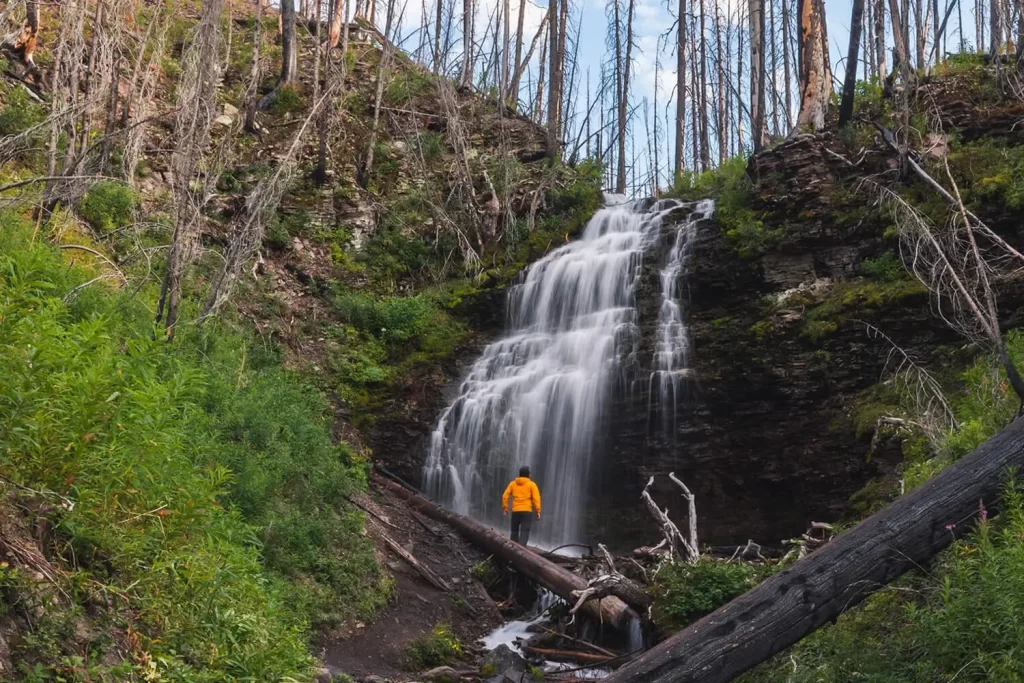
When to Visit Forum Falls
Like many waterfalls in the Rockies, the best time of year to visit is in late Spring. Melting snow and recent rainfall mean that the water level is at its highest, and the waterfalls at their most dramatic. Later in the year waterfalls lose a lot of their power, with some drying up to not much more of a trickle. Allison Creek Falls never fully dries up and to the best of my knowledge flows decently year round, but if visiting in late summer or autumn either try and time your visit with recent rainfall or lower your expectations accordingly.
Because the hike to Forum Falls is entirely through burned forest, expect no shade from the sun if hiking midday. It would be highly preferable to do the Forum Falls hike either in the morning or afternoon to avoid the hottest part of the day and the most direct sunlight.
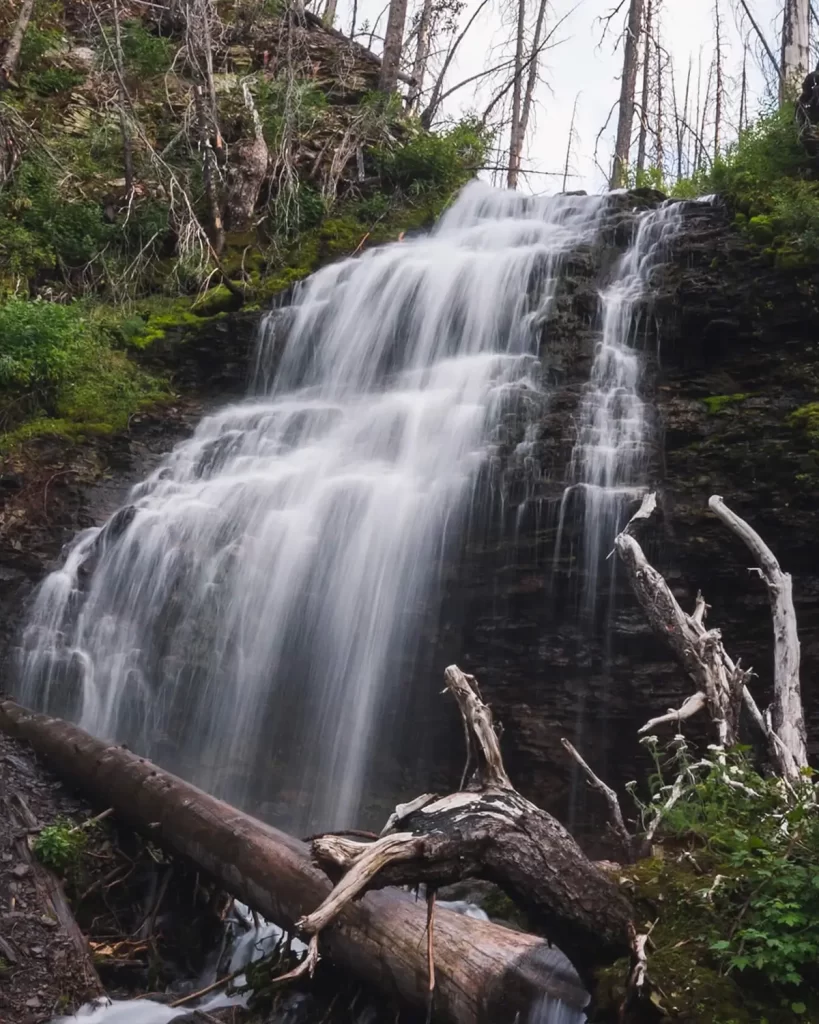
How to Get to Forum Falls Trailhead
The trailhead for the Forum Falls hike is located down the Akamina Parkway in Waterton Lakes National Park. When driving into the park, you will pass between the Prince of Wales Hotel on the left, and the small trailhead for the Bear’s Hump hike on the right. Continue along the highway as it heads down the hill into town, and take the immediate right to get onto the Akamina Parkway. If you find yourself in the Banff townsite, you’ve missed the turn. The large parking lot is located about 14 km down the Akamina Parkway. Pull off here and begin your hike on the opposite side of the road.
Waterton Lakes National Park is located just above the US border in the southeastern most corner of the Alberta Rockies, and forms half of an International Peace Park with Glacier National Park directly on the other side of the border. Driving here is three hours from Calgary, or an hour and a half from Lethbridge.
Click here to open the exact trailhead location in Google Maps.
Hiking to Forum Falls
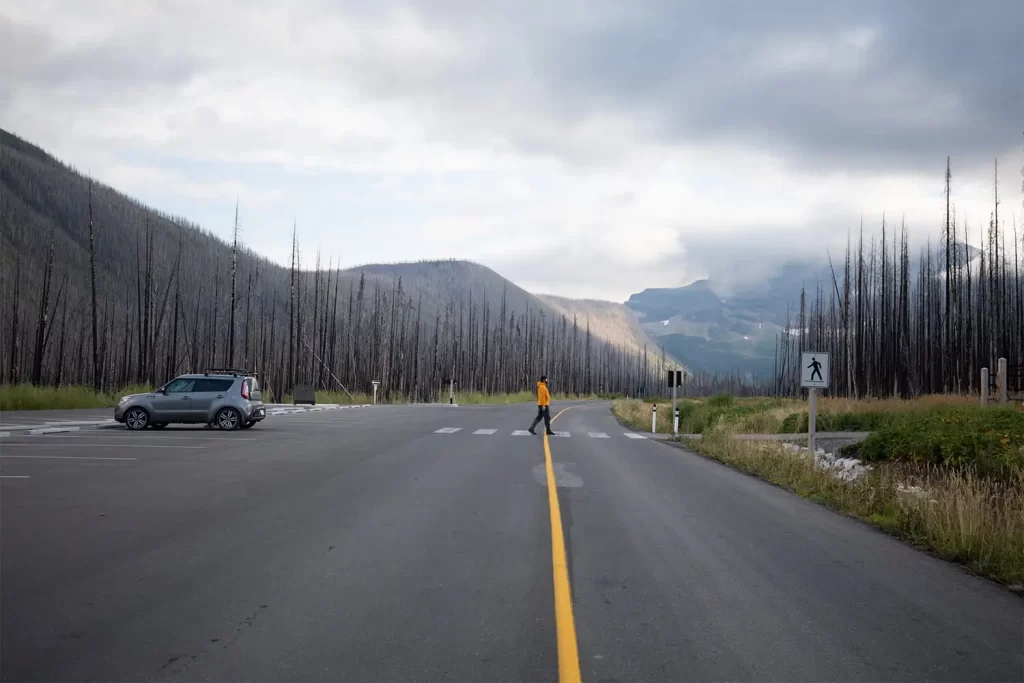
The burnt remnants of the 2017 Kenow wildfire looking particularly stark against the dramatic sky. The trail starts right from the parking lot.
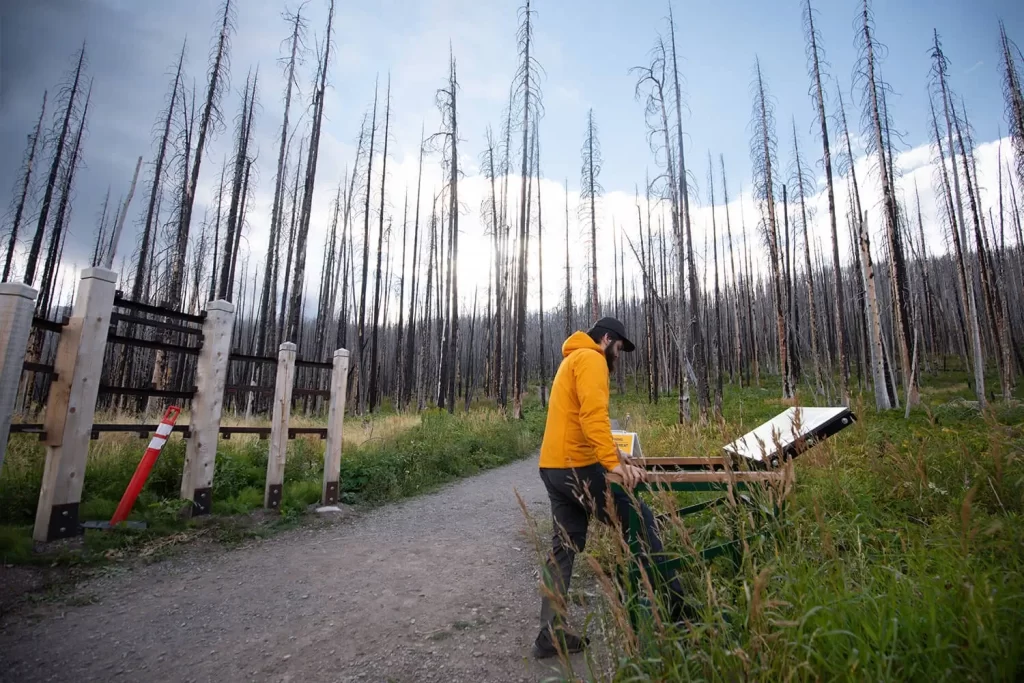
To help prevent the introduction of invasive species, it’s important to remove all mud and plant matter from footwear and clothes before hiking, as well using the foot brushing stations located at trailheads at the start of one’s hike.
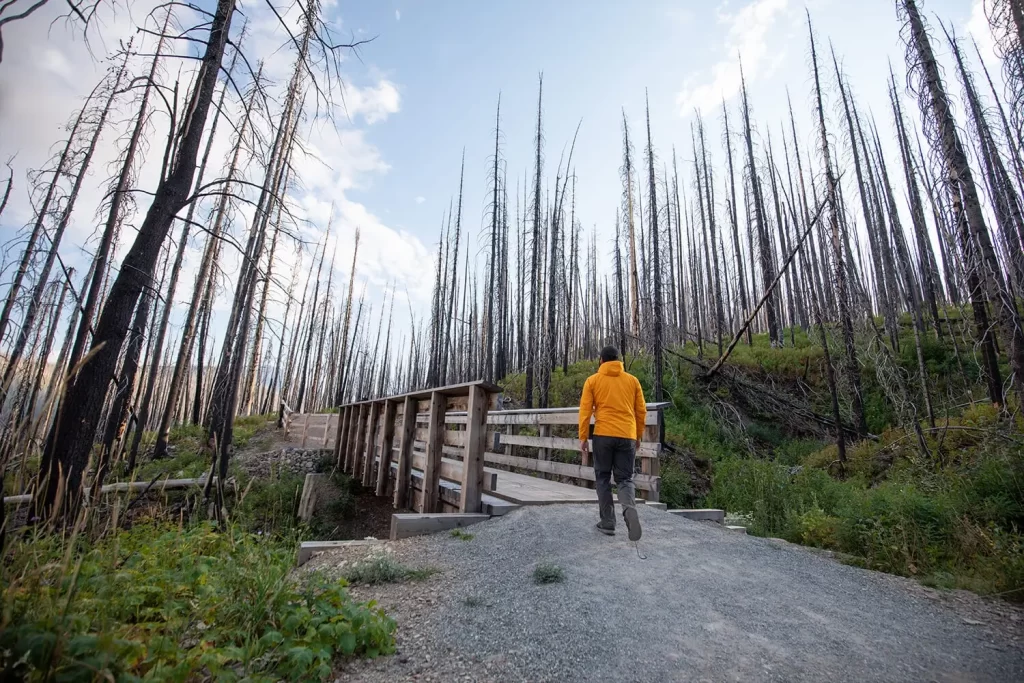
An early bridge crossing as the trail winds up, steadily gaining elevation through the burnt forest.
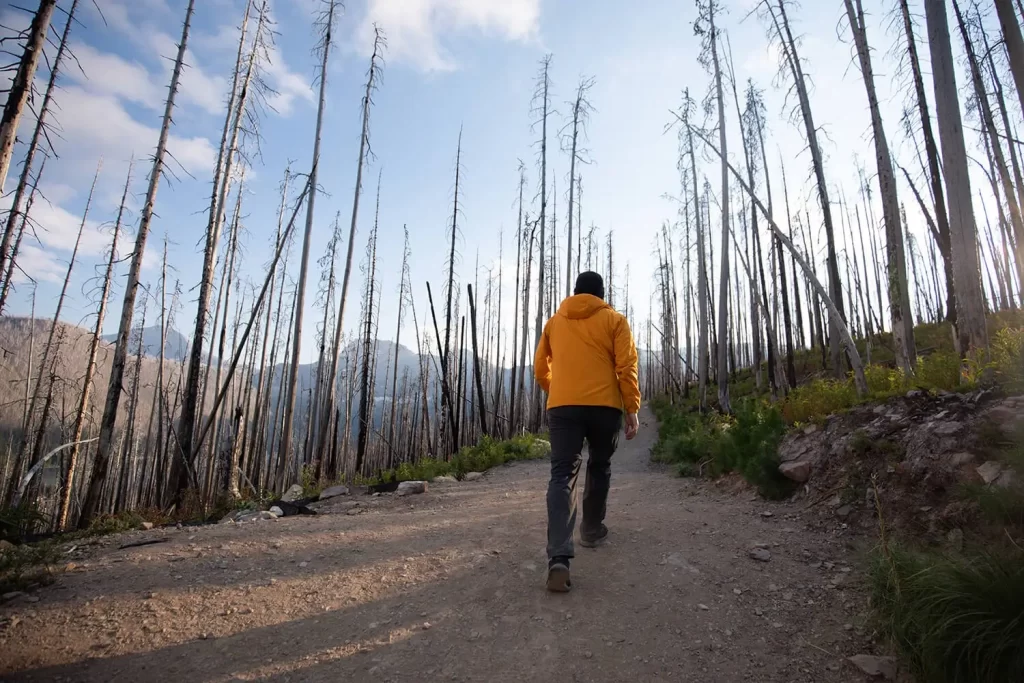
Mt Custer is the tall peak in the distance, located across the US border in Glacier National Park.
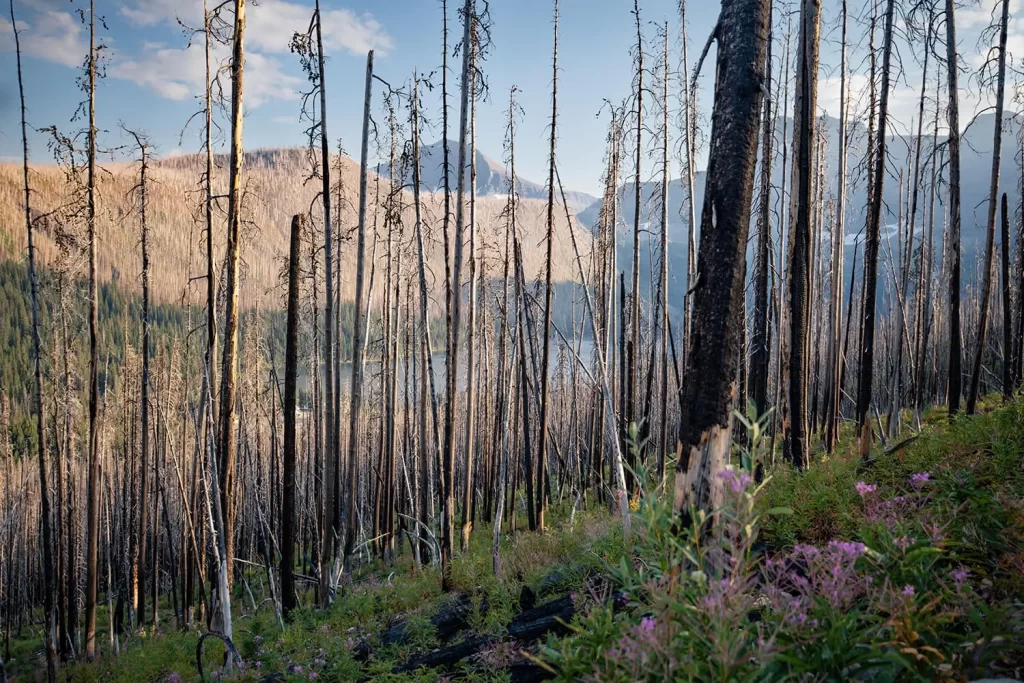
Beautiful Cameron Lake can be seen through the trees as well.
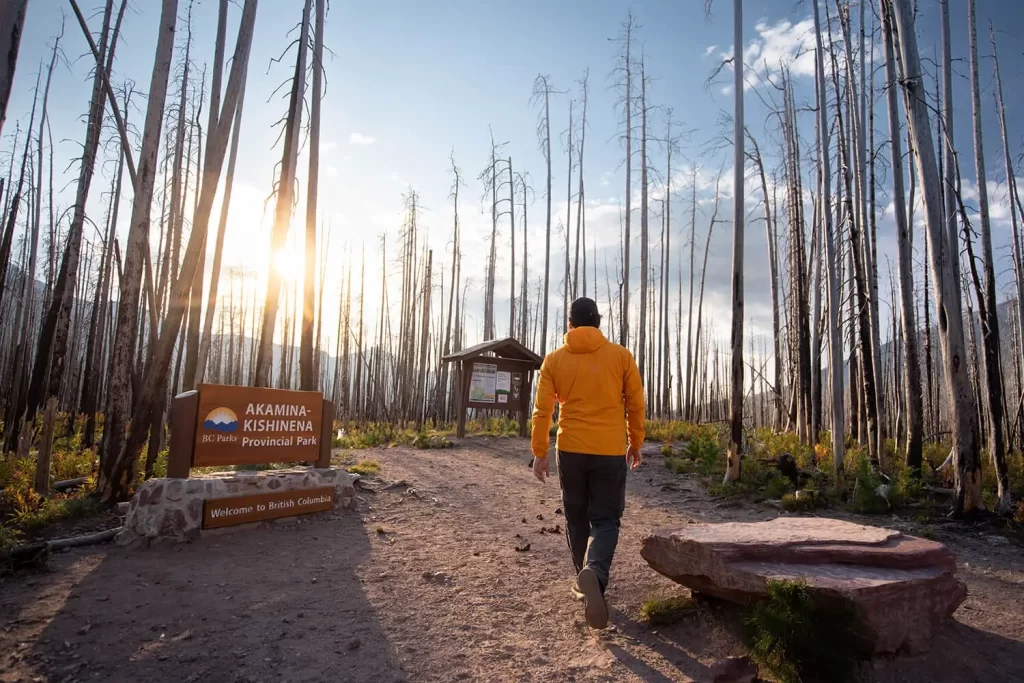
The Alberta/British Columbia provincial border is also the border between Waterton Lakes National Park and Akamina-Kishinena Provincial Park.
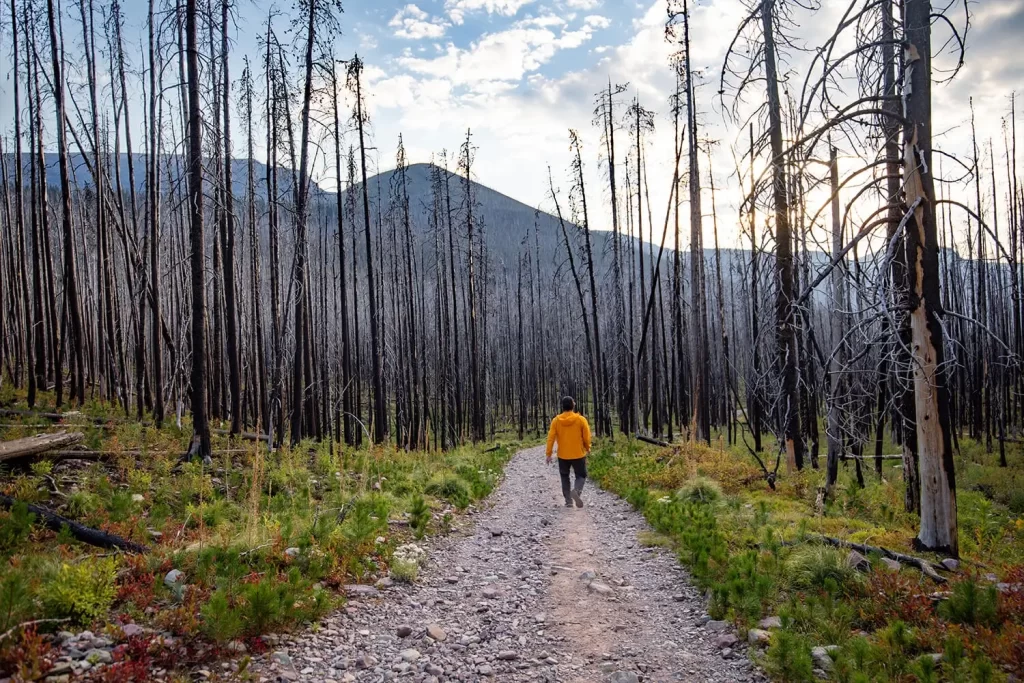
After crossing the border the path trends downhill for a while into Akamina Pass.

A well-signed intersection marks the correct turn towards Forum Falls.
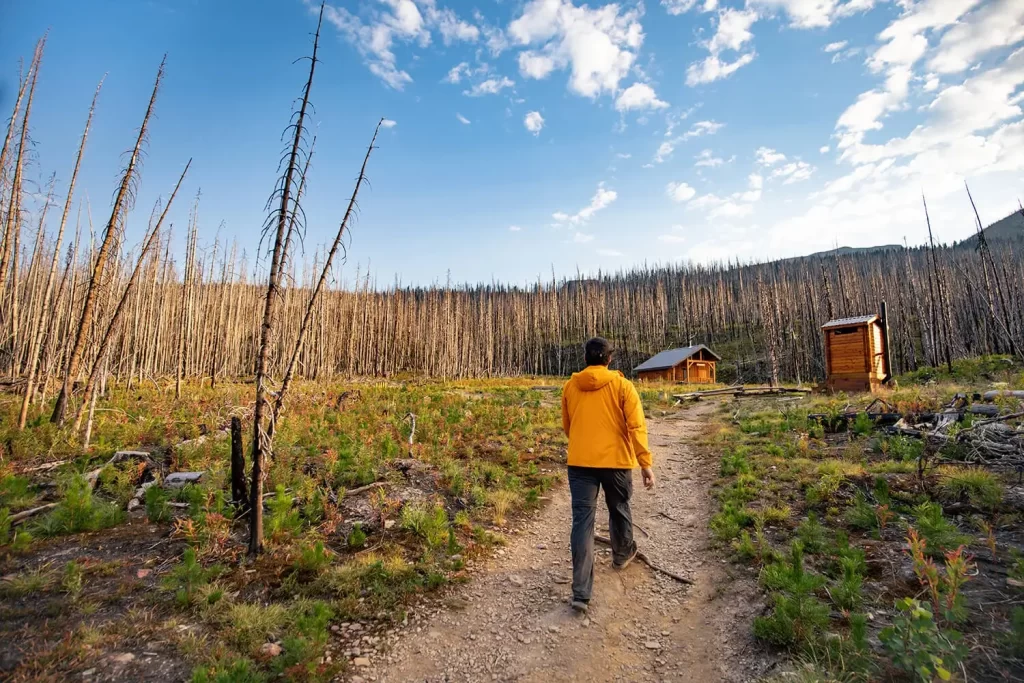
Recently-rebuilt campground facilities are only a couple minutes away from the waterfall, making this an ideal camping destination.
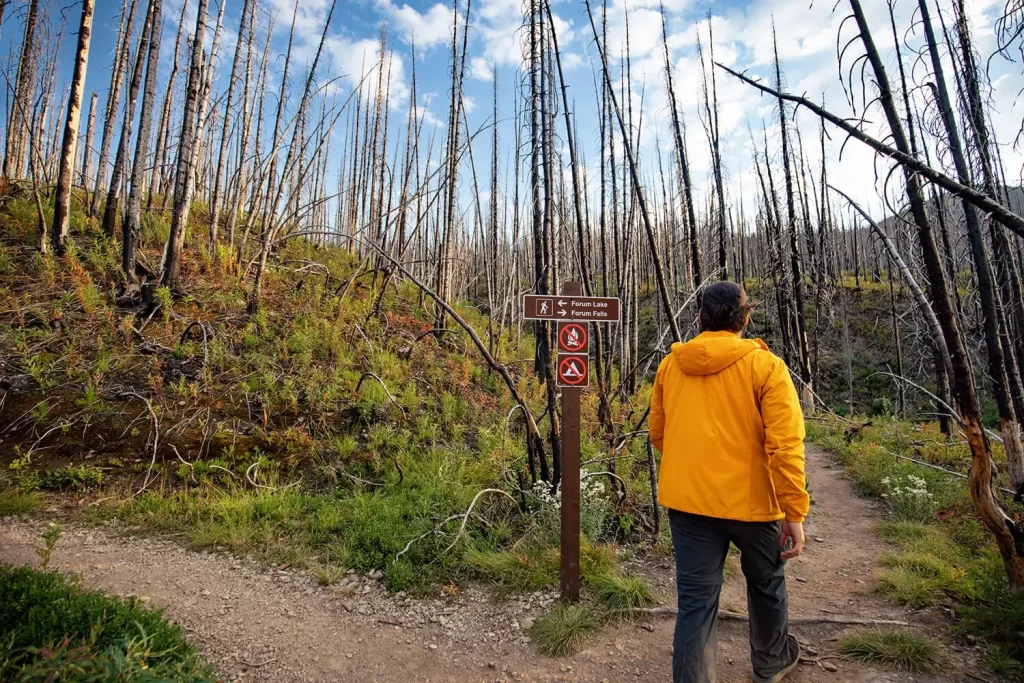
The longer hike to Forum Lake via the left trail is well worth it, but Forum Falls is only a couple minutes down the trail to the right.
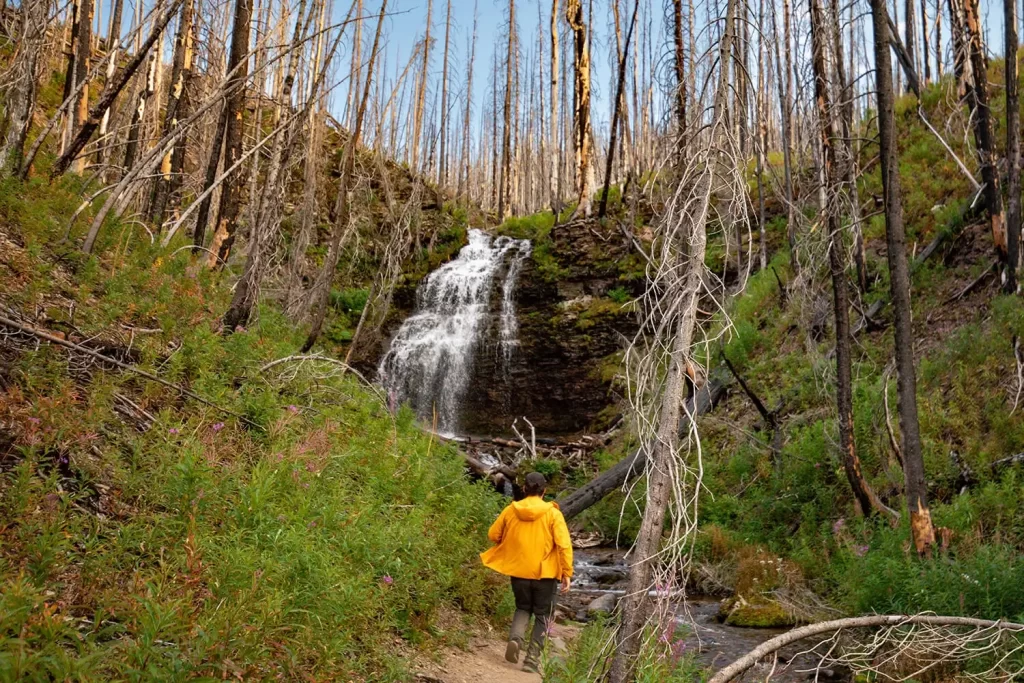
Beautiful Forum Falls stands out against the burnt trees.
Recommended Hiking Gear



Water is a must whenever I’m hiking, especially if the sun is going to be out. My favourite water filter I’ve used is the Katadyn BeFree 0.6L, which unlike other water filters I’ve used packs up really small and lightweight. For hikes where I know there won’t be any readily available water sources along the way, I make sure to bring my own. The Hydrapak Stow 1L bottle is my go-to, for the same reason that it’s made of a soft plastic that folds up and doesn’t take up any more extra space than necessary in my pack. Finally, Aquatabs are another great option for purifying water, with one tablet being suitable for one litre of water. I previously used the Grayl water filter while travelling internationally, and though I found its hard body more convenient for day to day use and easier to drink from, it has a little too much bulk for my fast-and-light style of hiking.



The secret to all my photos of gorgeous sunset and sunrise mountaintop views? A lot of hiking in the dark. And let me speak from personal experience when I say that the last thing that you want to happen when hiking is to be caught in the dark without a headlamp. I used the Black Diamond Spot 400 for years and it worked great – until I lost it on top of a mountain somewhere. The only downside to it was having to worry about the batteries dying, though there’s also a slightly more expensive version that has a rechargeable battery. Nowadays I’m using the Petzl Actik Core, which is a bit pricier than the more budget-friendly Black Diamond, but is also brighter, more comfortable (in my opinion), and has a hybrid power system that is rechargeable but can also take AAA batteries if needed.
You won’t see me using trekking poles on shorter hikes often – but on long hikes and backpacking trips, as well as certain scrambles, they are an absolute lifesaver. I’ve invested in a high quality ultra-lightweight pair of MSR DynaLock Ascent carbon poles which, while pricey, I don’t regret one bit. If you’re not entirely sure how much use you’re going to get out of a pair of trekking poles, the best budget-friendly option would be the Trekology Trek Z 2.0. Amazon does sell a lot of cheaper Made in China-style trekking poles for cheaper, but these usually are much much heavier and not worth buying.
All the best and most long-lasting cables and power banks I’ve ever owned have been Anker. I once had a phone cable from them that lasted me over three years of daily use! That’s why I keep an Anker PowerCore Essential 20K power bank on me. Like many people I use my phone for a lot of stuff when hiking (checking in with family, using online maps, taking photos, flying my drone) so I like to be prepared for that low battery warning by having a backup power source on me just in case.



The only socks I ever buy for myself are from Darn Tough, and I almost always make sure to wear them when hiking. After years of having no problems only wearing these comfortable and rugged socks for hikes, I accidentally wore a pair of no-name socks on a hike last year and ended up with blisters on both feet. Safe to say I’m back to sticking with the Darn Tough. And the best part? They have a lifetime guarantee, meaning that if they ever wear out you can send them back for a brand new pair. For hiking footwear I go between a pair of lightweight approach shoes for quick and dirty mountain ascents or anything involving scrambling and more heavy-duty boots for longer treks. I’ve worn a couple different versions of the lightweight but super durable Arc’teryx Konseal FL 2 approach shoes for a few years now and am very impressed with the durability. I also really like the thick toecap that keeps me protected every time I stumble into a root or large rock. For longer, tougher, or muddier treks I rely on my LOWA Camino EVO GTX, which I find insanely comfortable and made of very high quality.



I wear my Ar’teryx Gamma Lightweight Pants on every single hike I go on, and on many days when I’m not hiking. After several years of abuse they are still holding together extraordinarily well, with only a few small holes from where I’ve fallen down and some slight stains from being repeatedly coated with mud. They’re lightweight, breathable, and super comfortable. For lightweight and breathable hiking tops I’m a big fan of both the Patagonia Capilene Shirt and the MEC Core Shirt. My Arc’teryx Squamish Hoody shows up in a lot of my photos. It’s super lightweight and packable, and does a great job of cutting the wind while also being pretty breathable. I also have an Arc’teryx Atom Hoody and Arc’teryx Beta LT that I pull out for cooler or wetter conditions.
I hope you enjoyed this guide to hiking to Forum Falls in Akamina-Kishinena! Feel free to leave any questions in the comment section below or to contact me directly via social media.
